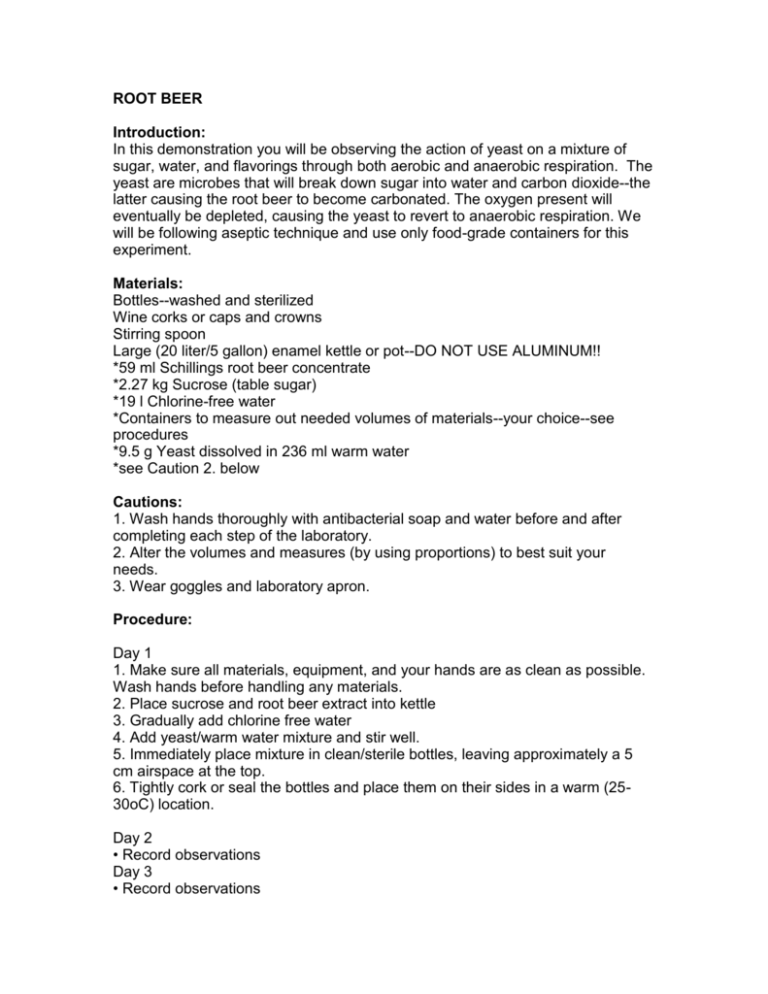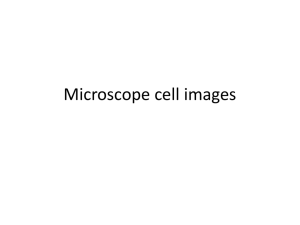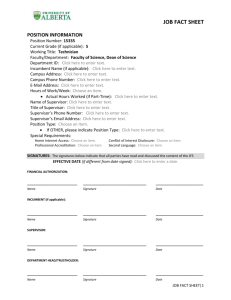ROOT BEER PRODUCTION - Idaho State University
advertisement

ROOT BEER Introduction: In this demonstration you will be observing the action of yeast on a mixture of sugar, water, and flavorings through both aerobic and anaerobic respiration. The yeast are microbes that will break down sugar into water and carbon dioxide--the latter causing the root beer to become carbonated. The oxygen present will eventually be depleted, causing the yeast to revert to anaerobic respiration. We will be following aseptic technique and use only food-grade containers for this experiment. Materials: Bottles--washed and sterilized Wine corks or caps and crowns Stirring spoon Large (20 liter/5 gallon) enamel kettle or pot--DO NOT USE ALUMINUM!! *59 ml Schillings root beer concentrate *2.27 kg Sucrose (table sugar) *19 l Chlorine-free water *Containers to measure out needed volumes of materials--your choice--see procedures *9.5 g Yeast dissolved in 236 ml warm water *see Caution 2. below Cautions: 1. Wash hands thoroughly with antibacterial soap and water before and after completing each step of the laboratory. 2. Alter the volumes and measures (by using proportions) to best suit your needs. 3. Wear goggles and laboratory apron. Procedure: Day 1 1. Make sure all materials, equipment, and your hands are as clean as possible. Wash hands before handling any materials. 2. Place sucrose and root beer extract into kettle 3. Gradually add chlorine free water 4. Add yeast/warm water mixture and stir well. 5. Immediately place mixture in clean/sterile bottles, leaving approximately a 5 cm airspace at the top. 6. Tightly cork or seal the bottles and place them on their sides in a warm (2530oC) location. Day 2 • Record observations Day 3 • Record observations Day 4 • Once refrigerated, your root beer should be ready for consumption!! Adapted from: • Nancy Heitel, et. al., "Production of Home Brewed Root Beer," Mankato State University, Mankato, MN, 1988 KIMCHEE: Introduction: Pickling is one of the most ancient forms of preserving food. You will be using microbes to convert sugars into lactic acid. The microbe involved is called lactobacilli. As the population of lactobacilli grows, they eat the natural sugars in plant juices and produce lactic acid as a waste product. As the lactic acid levels increase, so does the acidity. This highly acidic environment prevents the growth of other bacteria that would under normal conditions feast on the food causing spoilage. In this lab, you will be making kimchee and study lactic acid fermentation. Materials: Chinese cabbage (cut into 5-7 cm chunks) 1 red hot chili pepper, chopped 2 cloves garlic, thinly sliced non-iodized (pickling) salt quart glass jar plastic bag with water pH indicator paper small plastic pipette Microscope slids crystal violet stain microscope innoculating loop or tooth pick Procedure: Groups: Group 1: use 1 tsp. salt Group 2: use 2 tsp. salt Group 3: use 3 tsp. salt Day 1 1. Wash your hands thoroughly. 2. You will be using a glass jar and baggy filled with water to hold down the cabbage. 3. Alternate layers of cabbage, garlic, pepper and sprinkling of salt in the jar. Press each layer down firmly until the bottle is packed full. 4. Press down firmly on the top of the ingredients. Press down occasionally until the end of class. When there is space, fit the plastic bag filled with water into the jar, and tighten on the lid. Air should bubble out around the edges of the cabbage when you press down. Check daily to make sure to keep the cabbage covered by a layer of juice at all times. 5. You may need to add a small amount of clean water to keep the cabbage under juice by the end of the hour. 6. Measure and record the acidity of the fresh juice on top each day with a pH indicator paper. Day ??? 7. Place a drop of fresh juice on a microscope slide. Use the innoculating loop to spread it around the middle 1/3 of the slide. 8. Let the slide air dry. 9. Quickly pass the slide through the flame of the Bunsen burner 3-4 times. 10. Let the slide cool. 11. Cover the slide with 2-3 drops of crystal violet. 12. After 30 seconds rinse the slide with water. 13. Examine the slide under the microscope and draw the bacteria. 14. When the pH drops to 3.5, your kim chee will be ready. (About 3-7 days) Enjoy! Cautions: When working with chili peppers, take care not to touch eyes or mouth. Wash hands thoroughly when finished. Bottle used to ferment kim chee has been cleaned for you, do not open it until you are ready to place the ingredients inside.. Questions: 1. What does the salt do to the cabbage? 2. How do you think the salt affects this fermentation? 3. Is lactobacillus a salt-tolerant microorganism? 4. Don't forget to draw and describe the bacteria found in your kimchee. MAKING YOGURT Introduction: Yogurt production demonstrates fermentation by Streptococcus thermophilus and Lactobacillus bulgaricus. Heated milk is innoculated and maintained at a given temperature causing bacteria to grow and ferment lactose, the sugar in milk. The bacteria produce lactic acid which causes the milk to coagulate and adds a sour flavor. Be sure to follow aseptic technique and use only food-grade containers for this experiment. Materials: quart glass jar pH paper Food grade thermometer Microscope slides Hotplate Cooking pot Innoculating loop (a toothpick will work) 2 cups milk Crystal violet stain 1/3 cup nonfat dry milk Microscope (oil immersion if available) 2 tablespoons plain yogurt Procedure: Groups: Group 1 – whole milk Group 2 – 2% milk Group 3 – skim (nonfat) milk 1. Combine milk with nonfat dry milk and heat in a double boiler to 190° F. Hold at that temperature for 10 to 20 minutes so that the protein in the milk mixture will take up more water and make a better gel. Cool to 115° F (warm) and record the pH of the mixture. 2. Place the plain yogurt in a jar and gradually blend in the warm milk. 3. Cover. Place in a slightly warm styrofoam cooler. The temperature within the cooler should be about 110° to 120° F to provide optimum conditions for yogurt culture activity. 4. Allow to stand undisturbed until the mixture is firm when the jar is gently wiggled. This may take as long as 6 to 8 hours. 5. Record the pH of the yogurt. 6. Chill yogurt as soon as it is set. It can be stored in the refrigerator for up to 3 weeks. 7. Place a drop of water on the slide. Use the innoculating loop to mix a little yogurt with the water and spread it around the middle 1/3 of the slide. 8. Let the slide air dry. 9. Quickly pass the slide through the flame of the Bunsen burner 3-4 times. 10. Let the slide cool. 11. Cover the slide with 2-3 drops of crystal violet. 12. After 30 seconds rinse the slide with water. 13. Examine the slide under the microscope and draw the bacteria. 14. Add 2 tablespoons sugar and 1/4 cup fresh, crushed or frozen fruit . 15. Taste your yogurt. (Do not eat any yogurt that smells or looks bad! If in doubt, throw it out!) Questions: 1. What effect does the milk fat have on the finished product? 2. What do you think would happen if we increased the amount of sugar in the milk? 3. Why do you think we added the skim milk powder? 4. Don’t forget to draw and describe your bacteria. Yeast Bread Investigation Introduction: Bread dough is usually leavened by bakers' yeast (actively gas-producing strains of Saccharomyces cerevisiae ). Yeasts ferment the sugar in the dough, producing ethanol and carbon dioxide. CO2 is the leavening agent and the alcohol evaporates off during baking. Sometimes other gas-producing microorganisms are involved in bread leavening--these usually are heterofermenting lactic acid bacteria (sourdough bread or salt-rising bread) Commercial yeast is prepared and sold in two forms: yeast cakes and active dry yeasts. Yeast cakes contain, in addition to yeast cells, small amounts of starch, vegetable oils, and some lactic acid bacteria. Active dry yeast is made by drying the yeast cells to less than 80% moisture. These yeast cells are dried carefully at low temperatures so the cells will survive. When these yeast cells are stored at room temperature, they will retain their "dough-raising" ability for many months. Materials Bowl Mixing spoon Flour Yeast or starter Water Sugar Oil Plastic wrap Cookie sheet Microscope slides Crystal Violet Stain Microscope innoculating loop or tooth pick Procedures Group 1 - starter 1. Place ½ cup starter in bowl. 2. Add 11/2 cup flour and ¾ cup water. 3. Mix and add flour until dough is of correct consistency. 4. Let dough sit 5 min. While dough is sitting do the following. 5. Place a drop of water on a microscope slide. 6. Take a very small bit of starter and place it on a slide. 7. Use a tooth pick to mix the starter & water and spread it very thinly over the middle of the slide. 8. Let the slide air dry. 9. Quickly pass the slide through the flame of the Bunsen burner 3-4 times. 10. Let the slide cool. 11. Cover the slide with 2-3 drops of crystal violet. 12. After 30 seconds rinse the slide with water. 13. Examine the slide under the microscope and draw the bacteria. 14. Back to the dough - Add 1 tsp. salt and mix. 15. Roll into sticks and let rise 5 min. 16. Cook at 425F for 15-20 min. Groups 2&3 – rapid and regular yeast 1. Pour 1 cup warm water into bowl. 2. Dissolve yeast in bowl with warm water. 3. Place a drop of water on a microscope slide. 4. Take a very small bit of dissolved yeast and place it on a slide. 5. Use a tooth pick to mix the dissolved yeast & water and spread it very thinly over the middle of the slide. 6. Let the slide air dry. 7. Quickly pass the slide through the flame of the Bunsen burner 3-4 times. 8. Let the slide cool. 9. Cover the slide with 2-3 drops of crystal violet. 10. After 30 seconds rinse the slide with water. 11. Examine the slide under the microscope and draw the bacteria. 12. Add 21/2 cups flour, 2 tbs. oil, 1 tsp. sugar, 1 tsp. salt. 13. Mix to combine. 14. Let dough sit 5 min. 15. Roll into stick and let rise 5 min. 16. Cook at 425F for 15-20 min. Questions: 1. Describe and compare the three different types of bread sticks. Which one rose the highest? Which one had the best consistency? Which one tasted the best? 2. What factors can you think of that would effect how well the yeast rises? 3. The starter culture doesn't just have yeast in it. What do the other microbes do? 4. Don't forget to draw and describe the microorganisms from your slide preparation. References http://www.uwrf.edu/biotech/workshop/activity/act1/act1.pdf http://www.waksmanfoundation.org/labs/csuchico/labs1998.html http://www.bioteach.ubc.ca/Bioengineering/FoodMicrobiology/index.htm http://www.accessexcellence.org/LC/SS/ferm_references.html







